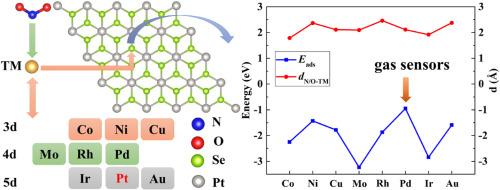单一过渡金属原子掺杂增强了1T-PtSe2单层膜对NO2的吸附
IF 2.9
3区 物理与天体物理
Q3 NANOSCIENCE & NANOTECHNOLOGY
Physica E-low-dimensional Systems & Nanostructures
Pub Date : 2025-07-29
DOI:10.1016/j.physe.2025.116341
引用次数: 0
摘要
利用密度泛函理论(DFT)系统地研究了在硒空位位置掺杂多种单一过渡金属(Co, Ni, Cu, Mo, Rh, Pd, Ir和Au)的单层1T-PtSe2的结构和电子性质,以及它们与NO2气体分子的相互作用。TM掺杂显著增强了PtSe2的化学反应活性,改变了PtSe2的电子结构,表现为NO2吸附增强,电荷转移增加,费米能级附近出现杂质态。这些效应主要是由于引入了促进分子活化的TM和轨道。在掺杂体系中,Pd-PtSe2在400-500 K范围内表现出优异的气敏性能,恢复时间短。这些发现为设计基于tm掺杂PtSe2单层膜的高效气体传感器提供了有价值的理论指导。本文章由计算机程序翻译,如有差异,请以英文原文为准。

Single transition-metal atom doping enhances NO2 adsorption on 1T-PtSe2 monolayer
The structural and electronic properties of monolayer 1T-PtSe2 doped with various single transition metal (TM) atoms (Co, Ni, Cu, Mo, Rh, Pd, Ir, and Au) at selenium vacancy sites, along with their interaction with NO2 gas molecules, have been systematically investigated using density functional theory (DFT). TM doping notably enhances the chemical reactivity and alters the electronic structure of PtSe2, as reflected in stronger NO2 adsorption, increased charge transfer, and the emergence of impurity states near the Fermi level. These effects are primarily attributed to the introduction of TM nd-orbitals, which facilitate molecular activation. Among the doped systems, Pd-PtSe2 demonstrates superior gas sensing performance with a short recovery time in the 400–500 K range. These findings provide valuable theoretical guidance for designing high-efficiency gas sensors based on TM-doped PtSe2 monolayers.
求助全文
通过发布文献求助,成功后即可免费获取论文全文。
去求助
来源期刊
CiteScore
7.30
自引率
6.10%
发文量
356
审稿时长
65 days
期刊介绍:
Physica E: Low-dimensional systems and nanostructures contains papers and invited review articles on the fundamental and applied aspects of physics in low-dimensional electron systems, in semiconductor heterostructures, oxide interfaces, quantum wells and superlattices, quantum wires and dots, novel quantum states of matter such as topological insulators, and Weyl semimetals.
Both theoretical and experimental contributions are invited. Topics suitable for publication in this journal include spin related phenomena, optical and transport properties, many-body effects, integer and fractional quantum Hall effects, quantum spin Hall effect, single electron effects and devices, Majorana fermions, and other novel phenomena.
Keywords:
• topological insulators/superconductors, majorana fermions, Wyel semimetals;
• quantum and neuromorphic computing/quantum information physics and devices based on low dimensional systems;
• layered superconductivity, low dimensional systems with superconducting proximity effect;
• 2D materials such as transition metal dichalcogenides;
• oxide heterostructures including ZnO, SrTiO3 etc;
• carbon nanostructures (graphene, carbon nanotubes, diamond NV center, etc.)
• quantum wells and superlattices;
• quantum Hall effect, quantum spin Hall effect, quantum anomalous Hall effect;
• optical- and phonons-related phenomena;
• magnetic-semiconductor structures;
• charge/spin-, magnon-, skyrmion-, Cooper pair- and majorana fermion- transport and tunneling;
• ultra-fast nonlinear optical phenomena;
• novel devices and applications (such as high performance sensor, solar cell, etc);
• novel growth and fabrication techniques for nanostructures

 求助内容:
求助内容: 应助结果提醒方式:
应助结果提醒方式:


